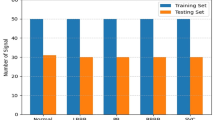Abstract
Our objective is to introduce a novel method of performing non-stationary signal analysis by means of enhanced training performance, suitable learning, and proper training dictionary elements in sparse representation techniques for real biomedical signal applications. Non-stationary signal characteristics pose severe challenges in terms of analysis and extraction of discriminant features. In addition, due to complexity of biomedical signals, the need for feature extraction algorithms that can localize to events of interest increases. To fulfil this objectives, we propose to use dictionary learning algorithms based on non-negative matrix factorization. This allows us to train the dictionary elements that lead to more robust classification performances. The proposed algorithm uses a time-frequency decomposition based on wavelet transform for non-stationary 1D biomedical signals. In this manuscript we aim to exploit non-stationary signal analysis through dictionary learning and study the discriminant features of these signals by means of sparse representation to design a robust algorithm in addition to higher classification performance.




Similar content being viewed by others
References
Ghoraani, B., Krishnan, S.: Time-frequency matrix feature extraction and classification of environmental audio signals. IEEE Trans. Audio Speech Lang. Process. 19(7), 2197–2209 (2011)
Ghoraani, B., Krishnan, S.: Discriminant non- stationary signal features clustering using hard and fuzzy cluster labeling. EURASIP J. Adv. Signal Process. 2012(1), 1–20 (2012)
Feng, Z., Liang, M.: Fault diagnosis of wind turbine planetary gearbox under non-stationary conditions via adaptive optimal kernel time-frequency analysis. Renew. Energy 66, 468–477 (2014)
Rubinstein, R., Bruckstein, A.M., Elad, M.: Dictionaries for sparse representation modeling. Proc. IEEE 98(6), 1045–1057 (2010)
Jafari, M.G., Plumbley, M.D.: Fast dictionary learning for sparse representations of speech signals. IEEE J. Sel. Top. Signal Process. 5(5), 1025–1031 (2011)
Rebollo-Neira, L.: Dictionary redundancy elimination. IEE Proc. Vision Image Signal Process. 151(1), 31–34 (2004)
Aharon, M., Elad, M., Bruckstein, A.: K-SVD: an algorithm for designing overcomplete dictionaries for sparse representation. IEEE Trans. Signal Process. 54(11), 4311–4322 (2006)
Wright, J., Yang, A.Y., Ganesh, A., Sastry, S.S., Ma, Y.: Robust face recognition via sparse representation. IEEE Trans. Pattern Anal. Mach. Intell. 31(2), 210–227 (2008)
Mairal, J., Elad, M., Sapiro, G.: Sparse representation for color image restoration. IEEE Trans. Image Process. 17(1), 53–69 (2008)
Aharon, M., Elad, M.: Sparse and redundant modeling of image content using an image-signature-dictionary. SIAM J. Imaging Sci. 1(3), 228–247 (2008)
Adams, R.J., Xu, Y., Canning, F.X.: Sparse pseudo inverse of the discrete plane wave transform. IEEE Trans. Antennas Propag. 56(2), 475–484 (2008)
Ghoraani, B., Krishnan, S.: A joint time-frequency and matrix decomposition feature extraction methodology for pathological voice classification. EURASIP J. Adv. Signal Process. 2009, 10 (2009)
Cichocki, A., Zdunek, R., Phan, A.H., Amari, S.I.: Nonnegative matrix and tensor factorizations: applications to exploratory multi-way data analysis and blind source separation. Wiley, Hoboken (2009)
Tropp, J.A.: Just relax: convex programming methods for identifying sparse signals in noise. IEEE Trans. Inform. Theory 52(3), 1030–1051 (2006)
Mishali, M., Eldar, Y.C.: Reduce and boost: recovering arbitrary sets of jointly sparse vectors. IEEE Trans. Signal Process. 56(10), 4692–4702 (2008)
Akçcakaya, M., Tarokh, V.: A frame construction and a universal distortion bound for sparse representations. IEEE Trans. Signal Process. 56(6), 2443–2450 (2008)
Hurley, N., Rickard, S.: Comparing measures of sparsity. IEEE Trans. Inform. Theory 55(10), 4723–4741 (2009)
Hoyer, P.O.: Non-negative matrix factorization with sparseness constraints. J. Mach. Learn. Res. 5, 1457–1469 (2004)
Shokrollahi, M., Krishnan, S.: Sleep EMG analysis using sparse signal representation and classification. In: Engineering in Medicine and Biology Society (EMBC), 2012 Annual International Conference of the IEEE, pp. 3480–3483 (2012). IEEE
Engan, K., Rao, B.D., Kreutz-Delgado, K.: Frame design using focuss with method of optimal directions (mod). In: Proceedings of NORSIG, vol. 99 (1999)
Aharon, M., Elad, M., Bruckstein, A.M.: K-SVD and its non-negative variant for dictionary design. In: Optics and Photonics 2005, pp. 591411–591411 (2005). International Society for Optics and Photonics
Jain, A.K.: Fundamentals of digital image processing. Prentice-Hall, Inc., Upper Saddle River, NJ (1989)
Shokrollahi, M., Krishnan, S., Jewell, D., Murray, B.: Analysis of the electromyogram of rapid eye movement sleep using wavelet techniques. In: Engineering in Medicine and Biology Society, 2009. EMBC 2009. Annual International Conference of the IEEE, pp. 2659–2662 (2009). IEEE
Acknowledgments
We would like to thank the Sleep Research Clinic at Sunnybrook Health and Science Center for providing us with the data and their useful guidelines.
Author information
Authors and Affiliations
Corresponding author
Additional information
This work was supported by National Scientists and Engineering Research Council (NSERC) and Canada Research Chairs (CRC) program.
Rights and permissions
About this article
Cite this article
Shokrollahi, M., Krishnan, S. Non-stationary signal feature characterization using adaptive dictionaries and non-negative matrix factorization. SIViP 10, 1025–1032 (2016). https://doi.org/10.1007/s11760-015-0854-5
Received:
Revised:
Accepted:
Published:
Issue Date:
DOI: https://doi.org/10.1007/s11760-015-0854-5




